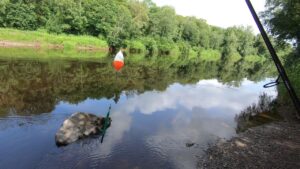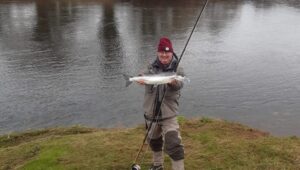
Good morning from a pleasantly mild Foxford. The season got quietly underway on Wednesday. As expected, there was a handful of anglers on the river and no fresh fish were reported. The first Salmon of the year has been claimed by the Blackwater, not a very big fish but it was fresh run and sea liced, well done to the lucky angler.
I was speaking to an angler the other day and we got to discussing different methods and the snobbery that exists among some anglers when it comes to Fly fishing versus other methods. He told me that last season he was fishing upstream of Foxford. There were a few visiting fly anglers who tried to belittle him for fishing with worms. This gentleman did not get involved in an argument but rather had a discussion about the skill involved in various methods. After a while the fly anglers became very interested in what he was saying and this gentleman ended up giving them a lesson on worm fishing. The fly anglers were intrigued and admitted that they did not know all that was involved in doing it properly. They all parted on good terms and I have no doubt some of them parted a little wiser. It has always been my opinion that the best Salmon angler is the one who is willing to change and has the knowledge and ability to adapt to varying situations and conditions. Theres room on the river bank for us all and just because someone has made a five-thousand-euro investment in top end fly gear and lessons to use it does not give them the right to think they are better than the guy with a humble worm. Its about respect for each other, the worm fisher does not need to leave his float in the middle of the pool for half an hour just to stop the fly angler passing through and the fly angler does not need to march down the middle of the river just because he wants to wade. Respect, give and take lads, the world will be a better place.
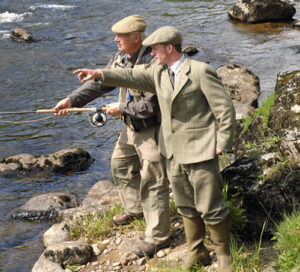
The next piece is something I have done before, I promised someone I would do it again early this season. It’s a little piece about prawn fishing, not everyone’s cup of tea but again I’d say don’t knock it until you have tried it.
Prawn fishing: Sometimes controversial often mysticised and definitely the victim of its own success the prawn has its place in the arsenal of any successful Salmon angler. Some of you are now smiling and some are growling and that is exactly how it is, different opinions. Its human nature, we disagree on certain things, argue, fight, criticise, condemn and generally go out of our way to prove our own side of the argument, prove that “I” am right. Yes, we can do this and we will always find evidence and points that prove our side of the argument. I’m not here to referee or say what’s right or wrong.

My first experience of Shrimp or Prawn fishing was in the 1970s. Of course, it has been practiced for a lot longer but it was during the 70s that it appeared on the Moy. Who the first angler to introduce it was is debatable, I’ve heard a few names. I can say with certainty that by the early 80s there was a handful of very successful anglers using it catching lots of Salmon throughout the season on the Moy. Back then Salmon were Valuable for different reasons than Salmon are valuable today. Money and employment were scarce, people did not have a lot and the value was a “Monetary” value. At that time, it was not seen as anything wrong to go fishing catch and kill as many fish as possible and sell them, it was the way of life. Not surprisingly the handful of anglers who had discovered this new wonderful bait were keen to keep it to themselves while the others who were not as successful became jealous. I could tell many funny stories of the attempts to discover the “Secret”, the rumours of scents and potions “witch craft”. Two sides with different opinions, the argument had begun! This is not the place to go into all the details of the argument for and against the bait but it has gone on for many years. I can summarise my own thoughts and findings easily, the prawn or shrimp is not the problem, the attitude of the angler using it is.
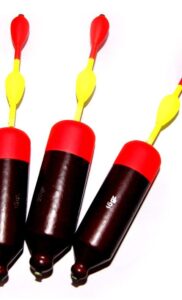
Time has moved on and in general attitudes have changed. Money and employment are not as scarce as they once were and times in general are easier. We have developed different attitudes and the values has changed. We now think more of the future of our sport and the survival of the species that we all love. Most of us will now agree that the Anglers who were good with the prawn did not have a magic potion and were in fact very good anglers with more knowledge than others. On a River like the Moy where a great amount of the channel is not suitable for Fly fishing, with a lot of deep holes and little flow on a lot of occasions the prawn is the only bait that will offer hope of success. If using a single hook fish can be easily unhooked and released if desired. For anyone who has tried the prawn I would say that in a very short time they discovered that the fish were not going to suddenly surrender. There’s quite a bit to get right before you will see positive results
The Bait: As anglers we generally refer to prawns as the guys with a sharp spike or horn on their heads, found in rock pools. Shrimps are the flat head versions normally found in sand. Beyond that I don’t actually know much about them as species. To the human eye there is relatively little difference in what we call prawn or shrimp. The fish it seems can differentiate and will at times favour one over the other. This is particularly noticeable towards the end of the season when they will very often take a shrimp and ignore a prawn.
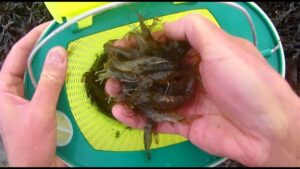
Colour: When caught fresh in the ocean prawns are translucent. After boiling them for a few minutes they turn a bright orange colour, known in angling circles as “Naturals”. Just who decided to dye them different colours I don’t know either but it certainly seems effective. Purple is the most popular colour but Red, Pink, and Green all work well. Sometimes a combination of colours is used in a “cocktail”
Single or cocktail: The single prawn is normally enough to take a fish however some of the better prawn anglers will often use a cocktail. The cocktail is made up of a single purple or red prawn combined with a slightly smaller prawn of a different colour. Known as a pointer this smaller prawn is placed on the Point of the hook. Popular combinations are Purple and natural, Red and Green, Purple and pink.
The set up: Similar to worm fishing it is possible to fish with or without a float. On the Moy using the float is by far the most popular method. The overall set up is similar to that for worm fishing, there are a few little differences. We start the set up by putting a stopper or stop knot on our main line. This stopper is movable and can be adjusted to suit different depths of water. After we have put on a stopper we slide a small plastic bead onto the line, normally an 8mm plastic bead is ideal. Make sure that the stop knot cannot slip through the hole in the bead and that the bead itself cannot slide through the hole in the float. Next, we put on our float. This is the first difference. When worm fishing the float is normally large and buoyant. For Prawn fishing we need to Fine things down a bit. The take and strike are fast and instant. Normally the float just disappears below the surface for a moment, during this moment the angler must strike. Readiness is key. The line from the rod tip to the float should be straight and tight, no slack line or big bellies of line lying on the surface. A lot of anglers use a line that floats or will grease their line to make it float. The reason for doing this is to reduce surface tension on the line so it lifts of the water easier for a quick strike. A cigar shaped float loaded using the appropriate weight so that it takes very little pressure to pull it under is used, the least resistance the fish feels when taking the better. Place another bead under the float and then tie on a swivel. Again, nothing to large or bulky about a size 10-barrel swivel is fine. To the other end of this swivel, we add approx. 20cm of monofilament onto which we slide our weight and under the weight a rubber buffer bead. Next, we attach another swivel of the same size. To the other end of this swivel, we attach a further 30cm of Monofilament at the end of which we attach our hook. Hook choice is a personal thing, some anglers choose to use a treble hook, normally size 8 or 10 and a straight mount known as a prawn pin which can slide on the line. This Prawn pin is passed through the prawn to straighten it before one of the hooks of the treble hook is inserted into the chin of the prawn. More accomplished Prawn anglers use a single hook which they thread the prawn onto, starting at the tail so that when mounted it hangs head down on the hook, a pointer can then be placed on the exposed hook tip. There’s a wide variety of suitable hooks on the market. A straight shank and wide gape are important. The stopper should now be set at a depth which is approx. 15cm less than the depth of the water where we plan to fish e.g. water is 2m deep set stop knot 1.85m. This will allow our prawn to hang close to the bottom of the river but not touching it. Our float will be “Cocked” standing straight on the surface.
From here on we are ready to fish. As I mentioned earlier the prawn is an effective bait but only if fished correctly. The anglers who are good with it have intimate knowledge of the waters they fish. This knowledge is the critical factor that makes all the difference between success and failure. If you ever have the opportunity to watch a good prawn angler you will notice that they change depths to suit exactly where they fish. As they move from pool to pool, they will adjust to suit. The really good ones have such knowledge that they can fish a pool with an uneven bottom and will know exactly when and where to raise their rod or hold back their prawn to rise it above an obstruction. It takes time to learn these things so don’t expect instant success. My advice would be to start with a few pools and move between them. (Normally and this is especially true with fresh fish that have arrived into a pool, if a fish is going to take a prawn it will do so in the first few casts over it) Spend a half an hour fishing one pool and move to another. Spend time figuring out the depths, where the obstructions are and where exactly the fish are lying. Concentrate and think about what you are doing, try different angles and control the speed you bait moves at. Look away for two seconds and i guarantee that’s when the fish will take, as you look back your float will just be re surfacing. We have all been there 😊
